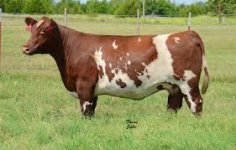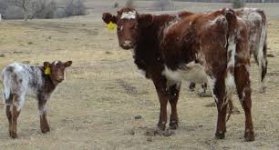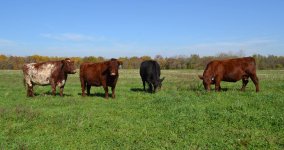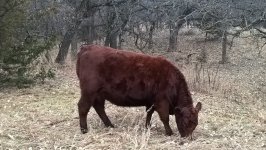Here's the article from 2005 that I referenced earlier. I feel it shows vision and leadership. I like that Doc Hunsley spelled out strengths and weaknesses and set some specific targets. I miss his research and scientific articles. I was hoping to see something similar after the recent conference. I am also still holding out hope that the 2016 Herd Reference Issue has a follow-up article and a similar "next ten year" vision from our CEO/Exec Secretary.
To give you perspective, in the July 2005 Shorthorn Country they still listed the known TH Carrier bulls (there were only 9 known carriers), Jakes Proud Jazz was not on the scene yet (not even mentioned in the issue...he'd become a household name in the following years), there was no TPS Coronet Leader 21 genetics or sons of retro or "native" bulls being promoted, a headshot of Webollabolla Theodore was on the cover, on page 104 Waukaru Farms and Dover Ranch were recognized as being nominated by the ASA for BIF Awards, there were a lot of Trump and Sonny genetics being promoted throughout the issue, and of course some things never change as Lauers and Lovings were promoting extremely low birthweight genetics (i.e: Ash Valley Double Duty 32x with a -4.8 BEPD, and from Lauer's ad "Herd Bull with Lowest Birth Weight EPD born and raised here (in Shorthorn Sire Summary, 2002, '03, '04, '05).")
The Next Decade
By Dr. Roger E. Hunsley
Issue 7 - Volume 32 - July, 2005 Shorthorn Country
Average membership tenure for a beef cattle association member is about seven years. This means that at the end of the next decade (2015) there will be many new names and faces joining the membership roll of the American Shorthorn Association.
The real strength of any breed organization is its membership. Retention of membership is important but attracting quality new members is paramount. Presently, the thrust of the membership is directed toward three areas of production, and subsequently, marketing. These areas are seedstock production, youth or junior project production and commercial industry production. The first two areas of production presently account for more than 95% of the Shorthorn and Shorthorn influence cattle produced and marketed annually.
Is it possible to change and/or expand the present production and marketing practices of the Shorthorn membership in the next decade? Perhaps, however, the advantages of the Shorthorn genetics must be maintained and strengthened and the weaknesses must be attacked and improved with vengeance.
Strengths of the Breed
The greatest strengths of the breed are: (1) its diverse gene pool: (2) maternal excellence of the breed; (3) overall carcass excellence of the breed, and (4) the great dispositions of Shorthorn cattle.
Diverse Gene Pool: The greatest advantage of a diverse gene pool comes from having variation in the breed. Most cattlemen say that they want to produce a uniform looking product. However, when these results are finally achieved, the gene pool is so narrow and limited that it becomes impossible to make immediate changes over a 10-year period to meet new market demands and industry challenges. Why? Because we do not have the genetic variation to accomplish the mission.
If the present appendix registry program of the ASA is monitored and maintained, the breed will always retain the genetic diversity advantage. This, along with the influence that is available from other countries, will help to maintain this advantage.
Maternal Excellence: Without a doubt, the maternal excellence of the
Shorthorn female is one of the greatest attributes of the breed. The ability to achieve puberty, conceive and calve at two years of age is extremely important. Shorthorns have excelled in this area forever. The ability to calve easy, rebreed and at the same time provide milk levels that are instrumental in producing heavy weaning weights are a monument of the breed. This results in progeny that have the ability to achieve a high dollar value at weaning time or as a yearling destined for the feedlot or as a finished product destined for the meat cooler. Selection pressure is paramount as the number one factor in documenting the bottom line in commercial beef production systems. This must result in a live calf every l2 months as a reward for carrying each beef cow unit. The maternal strength of the breed is responsible for this valuable industry asset.
Overall Carcass Excellence: Carcass excellence is a definite attribute of Shorthorn genetics. Shorthorn genetics are geared to produce a quality product. If you're interested in producing a lean product that has very little outside fat and very little intramuscular fat or marbling, then Shorthorn genetics are not for you. However, if you're interested in producing high quality carcasses that have acceptable marbling levels. outstanding eating quality, unparalleled tenderness and high product yield, Shorthorn genetics can get the job done.
Disposition: Without a doubt, one of the great attributes of the red, white and roan cattle is their disposition. Occasionally, you will find an owly one, but for the most part this breed is very mild mannered and easy to handle by young and old alike. Believe me, if you work closely with an animal on a daily basis, disposition will be your number one criteria for the daily relationship.
We must keep the selection pressure on disposition. There are some bloodlines that have a greater frequency of disposition problems or unruliness. Continue to select against this important factor in the beef cattle industry. It’s not only important when our youth are exhibiting Shorthorn cattle, but it’s also important in the pasture, in the feedlot, or anywhere else where close surroundings are involved in beef cattle handling and management programs.
It is important that the Shorthorn breed concentrates on promoting these great attributes but at the same time the leadership of this great industry must keep their focus on the barriers that are ahead. It is necessary to face the dilemma, regroup and base your decisions on sound, documented genetics and the rewards will continue to be forthcoming.
Breed Challenges
The biggest challenges facing the Shorthorn breed and its membership in the next decade are: 1) birth weight; 2) the use of DNA markers; 3) the production of fat; and 4) genetic soundness.
Birth Weight: Birth weight is considered to be the number one problem of the Shorthorn breed. There’s absolutely no other trait that is even close to birth weight when it comes to marketing Shorthorn genetics to a true production program that is a low labor input enterprise (commercial cattle program).
There are a number of sires in the Shorthorn breed that are used strictly to produce project animals for the junior members and they also contribute greatly to the birth weight problem. Everyone must continue to gather and turn in actual and accurate data in order to have a true assessment and evaluation of the genetics available in this industry and the Shorthorn breed in particular.
The average birth weight for all Shorthorn offspring reported to the Shorthorn Performance Records Program (SPR) is 86 pounds. It is an absolute must that the Shorthorn breeders reduce the birth weights to 80 pounds and no more. Remember, you have one decade to accomplish this task.
The number one criteria for any commercial cattleman that is looking at the purchase of a Shorthorn bull is birth weight. The birth weight EPD — yes, that is important but the true birth weight is still a very influential factor when it comes to commercial cattlemen's decisions regarding the use of Shorthorn genetics and Shorthorn bulls. It is not possible to say it any plainer. Your future depends on the selection pressure that Shorthorn breeders put on birth weight in the next two generations of Shorthorn beef cattle production. That's a maximum of 10 years. If not accomplished by then, the commercial cattlemen will be gone forever.
The 2005 National Shorthorn Sire Summary lists the non—parent average birth EPD as 1.8 with a standard deviation of 1.4. This is the same as the values reported for the 2003 and 2004 sire summaries. This would tell me that very little change is being made on behalf of the matings and resulting progeny that have been born in this breed in the last three years.
One standard deviation within a normally distributed population will include about two thirds of the individuals making up that population. Thus, 67% of all of the non-parent animals reported in the 2005 sire summary would have a birth weight EPD between 0.4 and 3.2. In my opinion, it would be very difficult to reduce birth weights and thus improve calving ease of Shorthorn sired progeny using any of the animals within one standard deviation of the mean ( 1.8 ). About 1/6 or 16.7% of the individuals in the Shorthorn breed will be more than one standard deviation below the mean or average. These cattle would be from a 1.0 to 0.4 for birth EPD. About 1/40th or 2.5% of the individuals will be two standard deviations below the breed average ( 1.8 ). These animals would have a birth EPD from a -2.4 to -1.0. As a result, it seems that if Shorthorn breeders really are destined to make improvement in the calving ease and perception of birth weight in the commercial cattlemen’s eyes, they must use some of the sires that are two or more standard deviations below the mean for birth weight. Is this happening?
Most Shorthorn breeders who sell commercial bulls must realize that even though they have very little or no difficult births in their herds, their commercial customer has a totally different cowherd with a totally different genetic base. Most Shorthorn cows can easily have a 90 pound calf; however, the average commercial cow faces a struggle at having a 90 pound calf unassisted 100% of the time. Let me point this out in another manner. How many calves did you have born this last year that were full term and weighed 80 pounds or less? How many calves did you have born full term that weighed between 81 and 90 pounds at birth? How many calves did you have born full term that weighed in excess of 90 pounds? If your numbers are larger for the calves that are in excess of 90 pounds than those that are 80 pounds or less, you need to do a new herd sire search.
There are a number of environmental factors that affect birth weight, but these are factors that every Shorthorn producer can control. The largest single factor, however, that affects birth weight is genetically controlled and the breeder can also do something about this trait. Keep in mind that most commercial cattlemen will not give you the second chance. Thus, you must make certain with the first bull or set of bulls that your genetics will work for him and produce a live calf as a result of every pregnant cow at the end of breeding season.
DNA Markers: Until DNA based tests became available, it was impossible to select directly for a number of very important factors that affect profitable beef production. In 2001 the first gene marker was released to the beef industry. This marker documented marbling through the use of a DNA based diagnostic test. This was the first time that a major gene associated with marbling in beef cattle had been identified and made available for commercial use. Thus, we have DNA technology that will allow us to make even better decisions on selecting and utilizing bloodlines. Breeders should use herd sires that have a high inherent propensity to increase and enhance the ability to marble, deposit high degrees of marbling at young ages and, at the same time, produce carcasses that are tender and provide a pleasant eating experience 100% of the time.
The cost of testing individual animals for the GeneSTAR marbling markers is $60 per test or $95 total or the two tests. This includes a test for one marbling marker and two tenderness markers. These would include the Calpastatin (Tl) marker and Calpain 1 (T2) marker at the $95 figure. If you request a single test of one of the aforementioned, the cost is $60. These rates apply for 1 through 25 samples. If the number of samples submitted is between 26 and 49, the cost of the combined tests is $85 and if 50 or more samples are tested, the cost is $75 per sample. These DNA Gene-STAR diagnostic tests are available through BOVIGEN LLC (
http://www.bovigen.com www.bovigen.com). BOVIGEN is planning to release a second DNA mar ling marker late in 2005. This market is called a feedlot marbling marker and relates more closely to documenting the ability of feedlot animals to achieve higher marbling levels during the feedlot period.
Recent communication with MMI Genomics, Inc. indicates that they are planning to release at least five new DNA markers for commercial use in the beef cattle industry. These markers should be released in 2005 and are markers for marbling, tenderness, back fat, yield grade and average daily gain. I am really excited about the average daily gain marker as well as additional tenderness and marbling markers. Costs are not available at this time; however, if interested, you should contact MMI Genomic at HYPERLINK "http://www.mmigenomirrxom"
www.mmigenomics.com. This firm is also developing a marker for the polled gene in Shorthorn cattle. It is impossible to measure how valuable this will be to the industry.
Many Shorthorn breeders will consider the cost of the DNA marker diagnostic tests to be too pricey. This technology does not come cheap but breeders must remember that it is advanced technology and is the real thing, not something that we think might happen. If you can improve the results of your decision making to the tune of 10—20% or more, can you afford not to take action? To date, the use of DNA GeneSTAR markers and Leptin (Igenity L) markers have resulted in an improvement in either marbling, tenderness or both traits From 10—20%. If you can improve performance or production 10% or more by the stroke of a pen and a mating decision, think what the future holds. If an lndy racecar driver can get 10% more speed legally, wouldn’t he be a fool not to pursue the technology?
At last report about 90%+ of all tested Shorthorn cattle were 2 STAR marker animals for the T1 (Calpastatin) tenderness trait. The T2 tenderness trait (Calpain l) is a different matter all together. The frequency of this marker in the tested Shorthorn cattle to date is extremely low (5-10% range).
Some Shorthorn cattle breeders have made the assessment that there is no need testing for tenderness since all the cattle have 2 STARS for the TI marker. You should be testing and evaluating your cattle for the opposite reason. That means eliminating the non—tender cattle from each breeding program as well as the entire breed.
Document your cattle and document your genetics if you are interested in marketing them. lf you're interested in being involved in the commercial industry and/or the industry that is producing “freezer beef" for retail be outlets across the country, you best be involved in looking at all the new technology that is geared toward carcass excellence. Tenderness and marbling are two of the most valuable traits that we have ever documented in the history of this industry. There are already two tenderness markers available and more to come. Hopefully, you can produce Shorthorn beef that will be guaranteed tender 100% of the time. This can happen in 10 years if you follow the road map.
Production of Fat: Fat has been documented as a detrimental factor when it comes to both Production and reproduction in beef cattle. Just like birth weight in calving difficulty, Fat production is a prime hindrance in a positive bottom line for any beef cattle enterprise. Without a doubt, the most expensive tissue we produce in the world is fat and beef cattle were producing an awful lot of fat in the 50‘s, 60‘s and 70's. The industry went through a time frame when the production of fat decreased drastically and now breeders are back on that same bandwagon and are producing fat at a break neck pace. In many uses fat seems to look like muscle and this optical illusion cannot be healthy for the Shorthorn breed. The breed was highly criticized for too much fat many years ago and that stigma is still out there. As a result, breeders must be highly cognizant of fat levels in their Shorthorn beef cattle.
Please do not get Shorthorn cattle “small” again. If you can't remember the problems that the breed faced in the 50's, 60’s and 70's, sit down and visit with someone who can. You're getting these cattle smaller and smaller and fatter and fatter every day. If this continues, you will lose production and increase your costs as a result.
Genetic Soundness: Your association and your Board of Directors are developing a detailed protocol for genetic diseases for the Shorthorn breed. This is being handled professionally and in the best interest of the breed. In the future, a DNA marker will be available to test the resulting carriers that are present in the existing gene pool.
Other Considerations
“Freezer Beef” Market Concept: Presently, there are a number of Shorthorn breeders involved in producing "freezer beef. At the same time breeders are producing beef carcasses that are used in a number of retail market outlets all across the country. This is undoubtedly one of the true niches for the Shorthorn breed. In some way, somehow the market venue for “freezer beef“ should be expanded through some direct promotion efforts. With the demand for Shorthorn carcasses for use in small retail outlets in the “freezer beef " concept, it simply gets back to the outstanding carcass attributes that are possessed by the breed. This includes not only the ability to marble at young ages but the ability to produce one of the most highly documented tender products of any beef cattle breed in the world. This is why it is so important to absolutely document tenderness through the use and verification of the DNA markers that are available or will become available in the future.
If the Shorthorn breed provides a pleasant eating experience as a result of critical consumers involved through the use of your product, you have made some great strides. It also gives you something substantial to base the future of your breed upon.
National Animal Identification System (NAIS): A national animal identification system has been bantered about for many years. However, the recent need for accountability and trace-ability of every animal in the livestock industry has resulted in a concept and is headed for approval, acceptance and implementation. The breed should adopt and promote this concept ASAP.
If we have a disease outbreak or “mad cow" syndrome is detected and documented within the borders of the U.S.A., absolute traceability and accountability are essential. Yes, I know all purebred Shorthorns are tattooed and thus, have a permanent ID. This identification system is encased in the archives of the American Shorthorn Association. The need to have a universal animal identification system is over and above those required by each individual breed association.
The time table is as follows. Individual animal identification numbers will be released starting in August 2005 and all animals owned by producers enrolled on a voluntary basis will be identified by early to mid-2006. Producers will be "alerted" in early to mid—2007 that enrollment will become mandatory. Regulations will be published mandating participation in 2008. Mandatory movement reporting will be implemented in early 2009 when the full implementation of the animal I.D. and tracking system will be in effect. The handwriting‘s on the wall and the time frame is in place. I would encourage every Shorthorn breeder that is involved with a commercial cattleman in any way to encourage that customer to sign up for the program. It’s a concept that is in use by many other countries around the world and it's time we all backed the effort of the NAIS and helped promote this concept.
SUMMARY
If breeders can decrease the birth weights of their Shorthorn offspring an average of six pounds in 10 years, everything else we have discussed in this article is mundane. If this does not happen, the commercial demand for Shorthorn bulls will be very, very limited in the future. However, I'm quite confident that it’s possible to knock six pounds off the average birth weight of all Shorthorn calves by the year 2015. If this is accomplished, breeders can continue to select for growth at weaning time, growth at one year of age and growth, gainability and efficiency at harvest time (14-20 months of age).
Please do not produce small, fat Shorthorns again. Keep balance in your decision making. Continue to produce that 52—54 inch steer at 12 to 18 months that can weigh 1,300 pounds and produce a yield grade 2.5 or leaner carcass. The resulting carcass should have enough marbling to grade USDA Choice or higher and generate a profit for the various segments of this beef cattle industry that handle animals from birth to consumption.
The technology is available to allow us to make accurate and absolute decisions about the genetics that are utilized in each and every breeding program. This has never been the case in the past. Breeders have never had access to genetic values that would accurately (100% of the time) produce the desired results. Some DNA markers are available with many others on the horizon. Pick and choose those that compliment your production goals for the next decade. By creating an atmosphere associated with technology and practicality that is conducive to generating a profitable bottom line, success is yours for the taking for the next decade. Good luck as you pursue your Shorthorn production endeavors.




